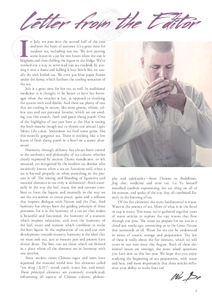
 |
|

In July, we pass into the second half of the year and into the heart of summer. It's a great time for outdoor tea, including sun tea. We love putting some leaves in a jar for two hours when the sun is brightest and then chilling the liquor in the fridge. We've worked out a way to serve iced sun tea roadside by putting it into a kama and ladling it into bowls like we usually do with boiled tea. We even put blue paper flames under the kama, which furthers the cooling sensation of the tea.
July is a great time for hot tea, as well. In traditional medicine, it is thought to be better to have hot beverages when the weather is hot, as opposed to shocking the system with iced drinks. And there are plenty of teas that are cooling in nature, like most greens, whites, yellow teas and our personal favorite, which we are sending you this month, fresh and green sheng puerh. One of the highlights of our year here at the Hut is tasting the fresh maocha (rough tea) to choose our annual Light Meets Life cakes. Sometimes we find some gems, like this month's gorgeous tea. There is nothing like a few leaves of fresh sheng puerh in a bowl on a sunny afternoon!
Harmony through alchemy has always been central to the aesthetics and philosophy of tea culture, whether clearly expressed by ancient Daoist mendicants, or left unstated, yet recognized by the modern tea drinker who intuitively knows when a tea set functions well, when a tea is brewed properly, or when something in the process is off. The mixing and blending of figurative and material elements in tea truly is alchemical - both externally in the way the leaf, water, fire and teaware combine to form the liquor; and internally in the way we use the tea session to create peace, quiet and a stillness that inspires dialogue with Nature and the Dao. And harmony has always been the guiding principle of these processes, for it is the harmony of a tea set that makes it beautiful and functional, the harmony of a tearoom which inspires relaxation, and even the harmony of the leaf, water and teaware which combines to make the best liquor. In the exploration of tea and our own development towards mastery, harmony is the ideal that we must seek out, just as masters past and present have always done. The best teas are those which are brewed in a place where all the elements are in harmony with one another.
Since ancient times Chinese sages and seers have separated the material world into five elements called "wu shing (五行)": wood, earth, water, fire, and metal. These principal elements are extremely complicated, influencing all aspects of Chinese culture, philosophy and spirituality - from Daoism to Buddhism, feng shui, medicine and even tea. Lu Yu himself inscribed symbols representing the wu shing on all of his teaware, and spoke of the way they all combined fluently in the brewing of tea.
Of the five elements, the most fundamental is water. Water is the essence of tea. More of what is in the bowl or cup is water. This issue, we've gathered together years of water articles to explore the vast waters that flow through our pots. The water we prepare for tea was in a cloud just weeks ago, connecting us to the Great Nature that surrounds us all. Water for tea can be understood in terms of source, storage and preparation. The last of these is really about the fire element, which we will cover in our next issue this August. Both of these elemental issues are amongst the most asked questions you have sent us this last year. We hope that you enjoy studying the beginning of tea preparation, with water and heat, and more importantly that these articles influence your ability to make finer tea!
